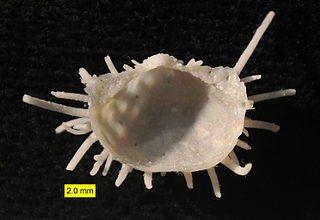
Scarabaeoidea is a superfamily of beetles, the only subgroup of the infraorder Scarabaeiformia. Around 35,000 species are placed in this superfamily and some 200 new species are described each year. Its constituent families are also undergoing revision presently, and the family list below is only preliminary. This superfamily includes some of the largest beetles extant today, including rhinoceros beetles, (Dynastinae), the Hercules beetle and Goliath beetles.

Ammonitida or "True ammonites" are an order of ammonoid cephalopods that lived from the Jurassic through Paleocene time periods, commonly with intricate ammonitic sutures.

Rissooidea, originally named Rissoacea by Gray, 1847, is a taxonomic superfamily of small and minute marine snails, belonging to the clade Littorinimorpha.

Dvinosaurs are one of several new clades of Temnospondyl amphibians named in the phylogenetic review of the group by Yates and Warren 2000. They represent a group of primitive semi-aquatic to completely aquatic amphibians, and are known from the Late Carboniferous to the Early Triassic, being most common in the Permian period. Their distinguishing characteristics are a reduction of the otic notch; the loss of a flange on the rear side of the pterygoid; and 28 or more presacral vertebrae.

Orthida is an extinct order of brachiopods which appeared during the Early Cambrian period and became very diverse by the Ordovician, living in shallow-shelf seas. Orthids are the oldest member of the subphylum Rhynchonelliformea, and is the order from which all other brachiopods of this group stem. Physically they are usually strophic, with well-developed interareas. They also commonly have radiating ribs, sulcus, and fold structures. Typically one valve, often the brachial valve, is flatter than the other. The interior structure of the brachial valves are usually simple. In shape they are sub-circular to elliptical, with typically biconvex valves.

Cypraeoidea, the cowries and cowry allies, is a superfamily of sea snails, marine gastropods included in the clade Littorinimorpha. This superfamily had been called Cypraeacea and was named by Rafinesque in 1815.

The Southern Plains woodrat is a species of rodent in the family Cricetidae. It is found in northwest Mexico and in Colorado, Kansas, New Mexico, Oklahoma, and Texas in the United States. The subspecies Neotoma micropus leucophaea, the White Sands woodrat, has white coloration, and is found only at White Sands National Park in New Mexico.
Thalassoceratoidea, formerly Thalassocerataceae, is a superfamily of Late Paleozoic ammonites characterized by their thick-discoidal to subglobular, involute shells with narrow or closed umbilici and biconvex growth striae with ventral sinuses. The ventral lobe of the suture, which straddles the outer rim, is wide, and bifid, with a tall median saddle.

Goniatitidae is one of three families included in the ammonoid cephalopod superfamily Goniatitoidea, known from the Lower Mississippian to the Upper Permian. They have sutures that form 8 lobes and characteristically lack sculpture. The ventral lobe, as for the superfamily, is bifurcated.

Spirostreptida is an order of long, cylindrical millipedes. There are approximately 1000 described species, making Spirostreptida the third largest order of millipedes after Polydesmida and Chordeumatida.

Eoderoceratoidea is a superfamily of true ammonites from the Lower Jurassic, comprising seven phylogenetically related families, characterized in general by having ribbed evolute shells that commonly bear spines or tubercles. Adult shell size ranges from 2 or 3 cm to giants reaching 50 cm in such genera as Apoderoceras, Epideroceras, and Liparoceras.

Perisphinctoidea, formerly Perisphinctaceae, is a superfamily of Middle Jurassic (Bajocian) to Lower Cretaceous (Barremian) ammonites, commonly with evolute shells with strong ribbing that typically divides about mid flank before crossing the venter.

Comatulida is an order of crinoids. Members of this order are known as feather stars and mostly do not have a stalk as adults. The oral surface with the mouth is facing upwards and is surrounded by five, often divided rays with feathery pinnules. Comatulids live on the seabed and on reefs in tropical and temperate waters.

Productida is an extinct order of brachiopods in the extinct class Strophomenata. Members of Productida first appeared during the Silurian. They represented the most abundant group of brachiopods during the Permian period, accounting for 45-70% of all species. The vast majority of species went extinct during the Permian-Triassic extinction event, though a handful survived into the Early Triassic. Many productids are covered in hollow tubular spines, which are characteristic of the group. A number of functions for the spines have been proposed, including as a defensive mechanism against predators.
An order of brachiopods containing the families:
Protorthida is an extinct order of Rhynchonellate brachiopods containing the taxa:
Enteletoidea is an extinct superfamily of brachiopods in the order Orthida, containing:
Orthoidea is a superfamily of brachiopods containing the families:
Lyttoniidina is a suborder of the brachiopod order Productida containing the families:
Productidina is a suborder of brachiopods containing the families:












